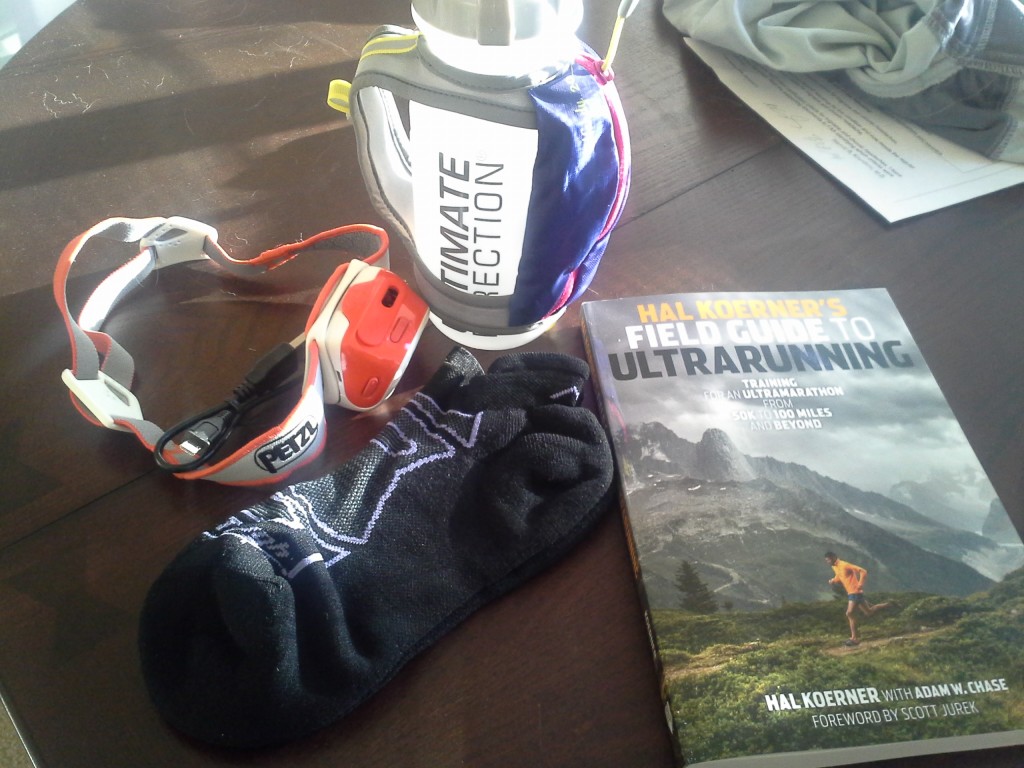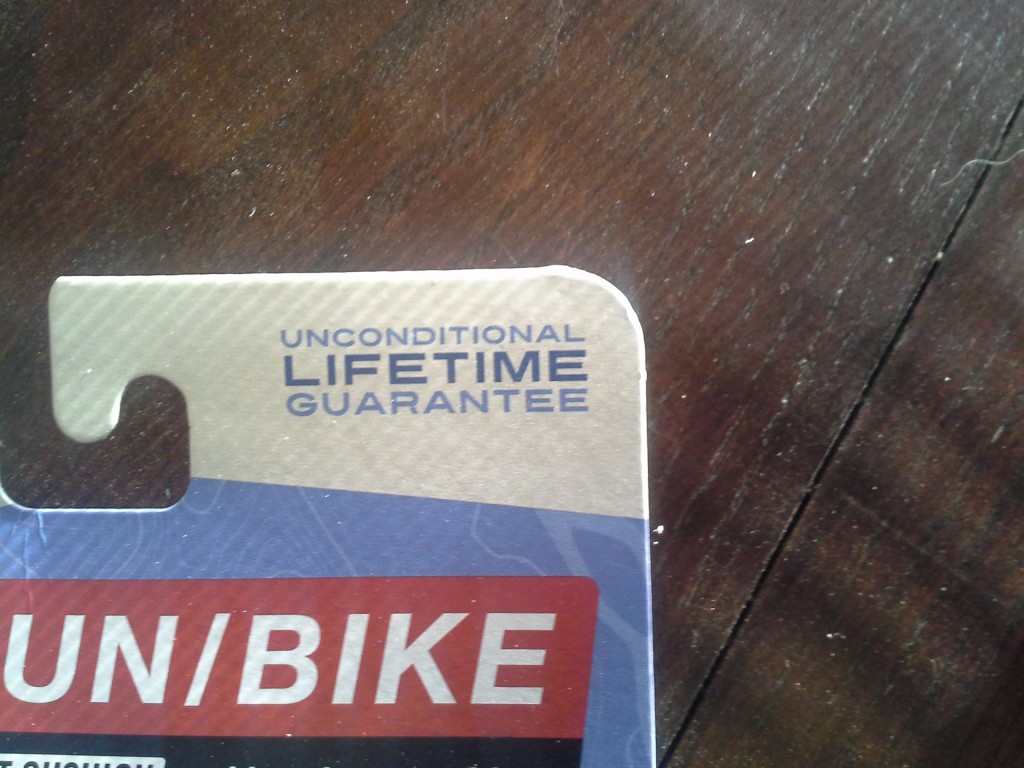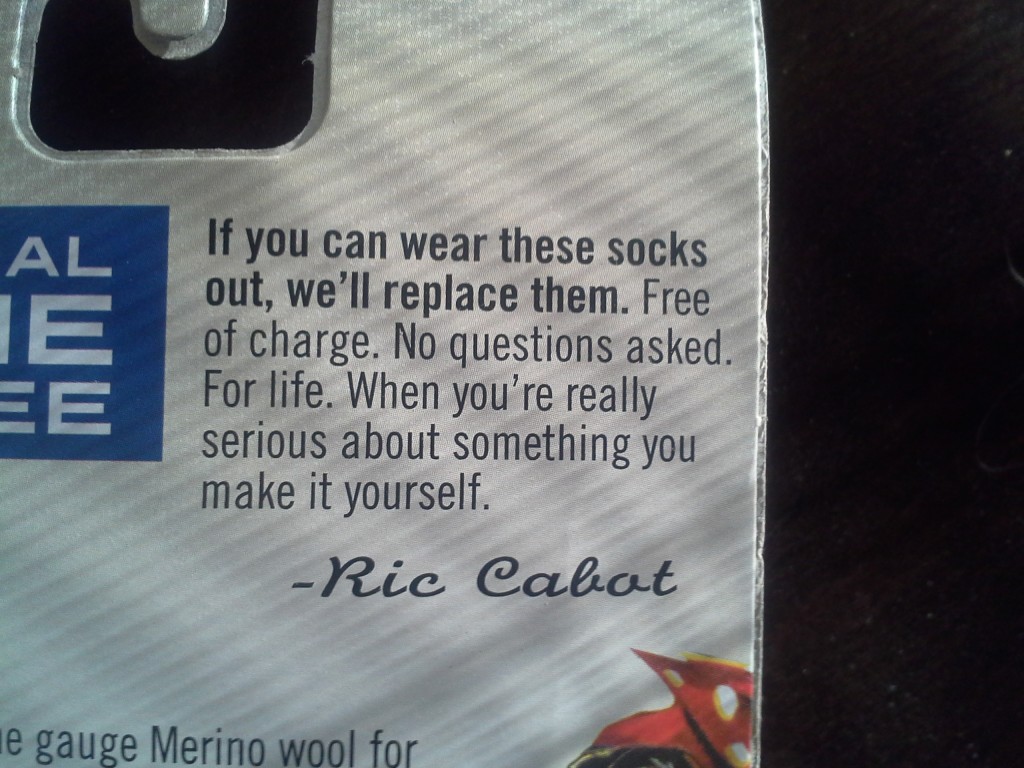Moving up a Distance
| August 19, 2014 | Posted by Melinda under Uncategorized |
 Somewhere between the Amazon boxes of clinic supplies and wedding stuff, I decided to include an order of running upgrades.
Somewhere between the Amazon boxes of clinic supplies and wedding stuff, I decided to include an order of running upgrades.
I have an older Petzl headlamp – but it’s not quite good enough to run at night. I’m tired of socks with holes in them. I saw this ultrarunning book as a review on a blog. I wanted a hand held water bottle option for races that were shorter with well stocked closely spaced aid stations.
In other words, I wanted a bunch of stuff that I didn’t necessarily *need*, but I *wanted*.
I haven’t run or ridden as much as I would like over the last couple weeks, and if I’m being realistic – planning a wedding and getting married (this weekend!) doesn’t bode well for my riding/running for the upcoming week either.
Yet, picking out these items, waiting for them to show up at my door, ripping open the packages, and arranging them on the table is almost as good as running. And sometimes, that’s as good as it’s going to get. Sorta like feeding at the barn this week 2x a day is almost as good as riding.
I have to admit that the other niggling thought behind this special package was that when I combine my finances with my soon-to-be husband, what is he going to think about $90 for a headlamp? or $15 socks? 🙂 (on the other hand, a fairly mentally stable Melinda = priceless).
It was when I was admiring my $15 socks that I saw this little note on the packaging.
What??????? Like for reals?
Wow.
$15 is what I pay for my Balegras and is the same neighborhood as the other running socks I’ve tried over the years – Wrightsocks, smartwool etc. I did a quick online search of the other brands’ sites to see if they offered a similar guarantee that I was unaware of….and nope. Darn Tough may be my new favorite sock.
In the spirit of *almost as good* as actually running and riding, I’ve been listening to running podcasts while feeding ponies.
Trail runner nation podcast had a good one that discussed what it takes to move to longer distances (listen here). I thought some of their points were interesting and wanted to share them with you, along with my own thoughts.
I’m not sure how much of the concepts really apply to horses – mostly because I don’t race shorter distances, and I feel as a rider I’m riding my own mental ride during the longer stuff that is sometimes separate and different from what the horse is going through.
Let’s get started.
“What’s different between the distances besides the sticker you put on your car”
Ideas I heard on the podcast in italics, my editorial in bullet points.
5K versus 10K
The most glaring differences between 5K to a 10k:
The 5K is painful the whole time because you are going out hard. In the 10K you have about a mile to settle.
- I would agree. Even as someone that has never raced a 5k (I’ve completed 2 5K’s – both were fun walks with friends), when I go out for a 3 mile tempo run, I push myself much harder than a fast 6 mile run. Later in the podcast, the commentators put it this way and I agree: 5k’s are painful while 10k’s are uncomfortable.
All abilities are toeing the line at the 5k from pro to green
- No matter where are you in your running, you are likely to find something *just like you* at the start line of a 5K.
Less commitment to training required than 10k for runner just getting started.
- Well, yeah. Sorta. However, I think it takes a lot MORE training to do the 5K well than to have a half way decent finish at a 10K. In my mind, there really isn’t a difference between the commitment to training for a 5k versus a 10K. Call me a snob, but if a friend in half way decent shape tells me they are training for a local 5K, I usually try to convince them to bump it up to a 10K. Not that much more training, and yet the experience on race day is a tad better.
In the 5K it is extremely difficult to make up mistakes and early position is important. The 10K has more room for error.
- Having never raced either of these distances I could see where this is theoretically true….
For those runners in the back of the pack a 10k could take an hour or more. That means for some runners this might mean a gear change (carrying a water bottle etc.) when switching from 5k to 10k.
Comparing the 5k/10k to even longer distances…..
Fueling and hydration is often optional at the shorter distances.
- Yeah…but that hasn’t stopped me from partaking of aid stations on a 10k trail race!
If you are pushing for a goal time in these shorter distances (5k, 10k) walking is usually failure. Compared to ultra distances where walking becomes a strategy.
- I’ve never heard it put this way, but I like it. Walking as strategy! Just like this.
Half vs Full
Where the stickers start!!!!
OK, fine. There *might* be bigger differences than the fact there are stickers available for your car.
Cramping in a half marathon is not usually an issue….but can become an issue in the marathon. (This might not true for back of the pack half marathoners).
- The commentators loosely associated the cramping as related to electrolyte, and thus in the marathon distance, unlike the shorter distances, the importance of electrolyte replacement is introduced. I agree! Even as a back of the pack (relatively) half marathoner I can get away with a LOT in that 13.1 distance. And if I do screw up hydration or electrolytes? Well…..that brings us to the next point:
In a half marathon if something goes wrong, can usually grit your teeth and get through it.
- I think now with my experience of going beyond the marathon distances a couple of times, I’m more capable of gritting my teeth and getting through a poorly executed marathon – but in general, it’s exponentially harder to do that in a marathon than a half marathon.
The marathon introduces the first metabolic wall – usually 20ish miles.
- I find that my first metabolic wall was before 20 miles – more like 16-18 miles – probably because I’m slower and time as well as distance plays into the metabolic walls. The presence of this metabolic wall makes fueling (water, sports drinks, calories) much more important in the marathon as compared to the 1/2 marathon.
A key difference between a 1/2 marathon and a marathon: A 1/2 marathon is a race. A marathon is an endurance event. The marathon finish comes with prestige.
- I agree. The marathon distance is where even non-runners want to know “did you finish?” or “how many have you finished?” and the exact finishing time takes second place to the finishing status.
Need to know body better in the marathon.
- Not sure if I have an opinion on this. Probably because I had already done a marathon by the time I tried a half.
The marathon distance introduces….chafing
Training for a marathon takes more commitment than for the half.
- See comments for 5K versus 10K. I think that the amount of time spent training for specific distances entirely depends on what your goals are – not necessarily miles. However, I once finished a half marathon on ZERO training. It wasn’t pretty, but I got through it. I couldn’t have done that in a full marathon distance.
Start of the mental game (can I do this?).
- I don’t think I’ve ever wondered whether I was going to get through a 5k, 10k or half. But a marathon is definitely a different game. For the marathon distance I’ve found the more I do, the less I wonder whether I’m capable of doing the distance – but like doing a 50 miler on the horse, even when you’ve finished countless rides including 100’s, you have to respect the distance, even when it’s “just” another 50 or “just” another marathon.
Marathon versus 50K?
How 50k different from marathon: Terrain. That’s it.
- You can chose a 50k that is flat and road like, or a marathon that is hilly, but in general training for the actual distance is the same for 50k versus marathon.
This is the break between traditionally trail runs and road races. Yes, there are exceptions both directions, but in general by choosing a 50k and beyond, you are signing up for a trail experience that goes beyond the simple distance.
In general this means that Footwear, Navigation, and Proprioception on the trail becomes very important.
- I agree. I care so much more about feeling the trail and it’s almost impossible for me to run well (fast without tripping) without the right footwear that provides the right proprioception appropriate for the trail. I think it’s telling that I went from having ONE pair of running shoes for my road running that I used for all training and racing, to at least FIVE different running shoe options once I started doing trails. Navigation and having a sense where you are and where you are going – as well as getting a feel for the “personality” of the trail marker – is far more important on trails than roads.
50 miles
Instead of breaking it down like the they did on previous distances, the discussion of 50 milers and 100 milers was more of a…..general discussion.
I was sorta disappointed since I’m looking at the 100 mile distance nervously and so much of their other advice was spot on in my experiences, which made me trust what they had to say about the mysterious 100 mile distance.
For 50 milers every thing changes. Pacing and strategy are completely different from a marathon. Finding a pack to run with is not as important. 50 miles is a long way to run someone else’s race – running your own race becomes very important whereas in the shorter distances running with the right “pack” is important.
- I really liked the phrase “50 miles is a long way to run someone else’s race”. That is true whether you are on foot or on a horse. It’s fine to pace with someone for a couple of miles – or longer if the pace is according to your strategy. But to go along at a pace too far outside your comfort zone for too long….just a really bad idea at this distance.
Mental game of the unknown more significant.
- I don’t have a tremendous amount of experience in the 50 mile distance but I found that the mental game was very important. I didn’t find the 50 mile distance any more physical hard than a marathon or 50k. But managing my brain, thoughts, and stress was much more involved.
Fueling very important. Many people find they need to eat real food and not rely entirely on gu’s etc. .
If you aren’t in front trying to win…..there’s a LOT of visiting and taking care of small stuff and taking pictures and posting to facebook….
- AGREE. Long races are a way to catch up with friends, listen to podcasts, and enjoy the food and drink.
The best way to summarize the difference between road marathon at a longer trail race? Aid station worker behavior. At a marathon, the aid station volunteers have arms outstretched with cups of sports drinks and water. At a long trail race, the volunteers have their arms outstretched….for hugs. The cups are on the table, the food is laid out, and the expectation is you will at least slow, and perhaps chat a bit.
What I find interesting is that at the 50 (and 100) mile distances the commentators ceased to talk about how increasing mileage races command an additional commitment to training. I’m not sure if that’s because they training commitment isn’t that much more once you get above marathon (ie there’s only so much time to train and you are already maxed out) or if they consider it such a given, they they don’t mention it. In my limited experience, the amount of training I put in for marathons and 50’s was about the same – the difference being that I choose longer races (I tend to use races as training runs up to my goal race) – but the mileage I’m putting in at home is about the same.
100 miles
The difference between a 100 miler and a 50 miler is far beyond fifty miles.
- In my limited experience (ie ONE fifty!) it was easier than 2 marathons. Even if I use my easiest marathons in the equation. In many ways I felt better after my fifty than the majority of my marathons. I’m not sure if this will continue to hold true for future fifties. It’s a bit daunting to think that 100 miles is more difficult than 2 50’s
The only other 3 clues I got from the discussion about running 100 miles was this:
- Pacers can be really important in a 100 mile race. As a mental game, you are actually running 2 race – the first being the race to the pacer and then…you keep running for whatever you have left.
- If you want to see how running 100 miles is like, be a pacer for a 100 mile runner for a later stage in their race.
- Keep running the shorter distances. Don’t just do 100’s – the shorter distances can keep you sharp.













I bought a pair of Darn Tough socks last winter (they are local, made in Vermont!) and sadly I don’t like them quite as much as Smartwool. They didn’t breathe quite as well.
They are holding up much better though, I will give them that! Even as a non-runner I wear through Smartwool socks in 2-3 seasons of winter riding.
my only problem with them so far is that they are sized smaller than the Balegras and my other sock brands and I didn’t realize that I should have gotten a medium instead of a small. My toes feel sorta cramped. I usually wear a size 8 shoe….but if it’s a sandel type shoe than it’s closer to a 7.5 (I have wide feet). Usually the small socks go to a size 8 or so and so I’m usually a small. Darn Tough socks size small is up to a 7.5 shoe size and I’m really wishing I sized up :(. hopeing they stretch a tad as they wear and I’m good about not drying wool socks in the drying so hopefully they don’t shrink!
I had to google how to use the water bottle pictured which Matt thought was exceedingly stupid. LOL. I think he’s waited all these years for my legs to fall off or something from running distance and is a bit shocked that a decade later I’m still capable of running? Skeptical is how I would describe it – both that I do it AND the equipment I need for it. Sorta cracks me up.
re: $90 in running crap: you’re just giving him fair warning, one last time. “I am still the crazy endurer, honey!”
I *just* bought a pair of Darn Tough socks last week at REI. I hope we like them!